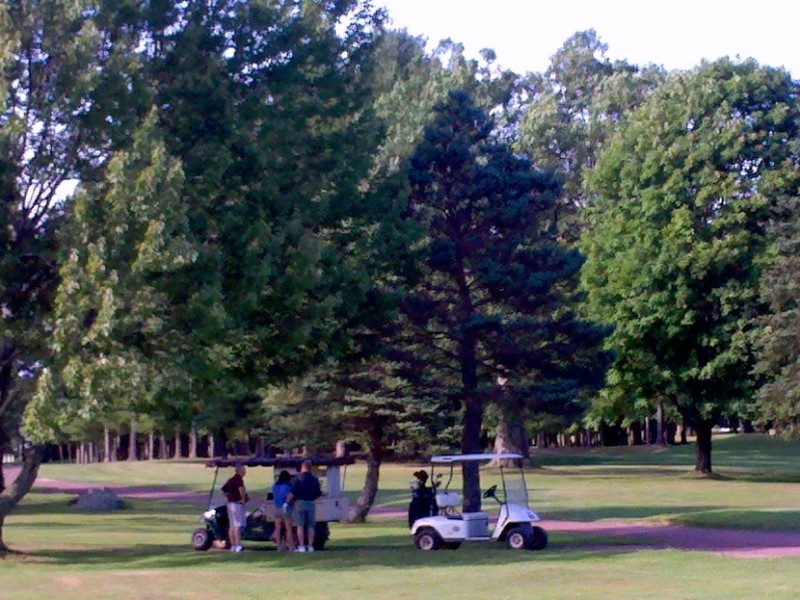What’s in your bag – a long putter or a short putter? As a new golf season is underway, I thought it would be a good time to answer that question. Let’s go back to the 2012 season, way back to April 2012. That is when we first saw something that made us all cringe. I.K. Kim, a young woman on the LPGA tour missed a one foot putt. Yes, I said it. A one foot putt that cost her a major championship. As she missed it she put her hands to her mouth and let out a gasp, the same reaction as those of us watching at home. It’s a stroke she cannot get back and one that will haunt her for a long while I assume. In this case it was a young woman who is a good putter and will continue to be a good putter. She just happened to miss a short one. But for the rest of us, it was a glimpse into something many of us struggle with and are afraid to talk about. That subject is really what we are discussing here. Ok. Get ready. I am going to say the word now YIPPS. Ok, there I said it. I have them and I am not ashamed to admit it. Hence the long putter. I will get into whether it should be legal or not a bit later; first I want to take a look at the great players around the world who have the yipps. But first, give credit where credit is due. So far in 2013, the short putters have ruled. Wins by Tiger, Phil and Brant Snedeker, all obviously not suffering from the yipps. Ok, back to 2012: Bubba Watson won the Masters. He managed to win without ever making a meaningful putt. He dismantled Augusta hitting not much more than a wedge into every green. Yet he still had to win in a playoff. His putting has always been the weakest part of his game but it really showed at Augusta. It’s something we’ve seen many times; somebody hitting the ball far better than anyone but can’t get that little ball into the hole. If not for the best shot of the year, a pitching wedge from the woods with 40 yards of curve on it, he would not have won. If his shot had landed just a few yards short of the green I don’t think he wins., He would have been forced to chip it close and stand over a putt of probably 4 feet or so. That is a length I have not seen him make too many of. Same as the rest of us. He instead was able to cozy up a 40 foot putt to about a foot and a half and knock that in. Bubba is just one of many of his peers who have a tough time with those putts. That little twinge in our hands that makes the putter do something bad. The YIPPS.
The 2012 US Open, our first major won without a meaningful putt being made by the winner, was a precursor to the rest of the year. The US Open, won by a very nice fella with a belly putter; his name is Webb Simpson. The putter jammed into his belly so that twinge can’t make the putter move off line. As he sunk the winning putt 45 minutes before he knew it was the winning putt, we were all left to wonder if he would have made it had he known it was for the win. As the other competitors collapsed down the stretch missing putts left and right, especially Jim Furyk and Ernie Els, we had no idea how Furyk’s misses would come back later to haunt us in the Ryder Cup. It was our first look into what we all know, the older you get, closer to that 40 year mark, the YIPPS
The Open Championship turned out to be a nightmare for the R&A and the USGA. Adam Scott lead most of the way, using the long putter; anchored to his chest as he swept the putter back and forth. This is another player who hits the ball as good as or better than just about anyone but cannot make a putt to save his life. Using this putter allows him to compete when he probably can’t anymore. Even this style of putter finally fell to the pressure as he could not make a putt on the final holes and lost a four shot lead to Ernie Els. Ernie, sporting the belly putter jabbed so far into his chest he could barely breathe. He made a 20 foot par putt to win. He did not know at the time it was for the win, thank goodness for him since earlier in the year he looked like he was holding a rattlesnake ( I stole that line ) when the putt was for the actual win. Anchoring the putter allows you to stay competitive when you have this issue. If you’re in the mix, then anything can happen. Watching it live was nerve racking, especially for me because I have felt that twinge many times. The YIPPS are a brutal part of many good players’ games and dealing with them definitely is easier when you can anchor the putter.
The last major was actually fairly calm. The best player in the world, who may be the best putter in the world, won fairly easily. Rory Mcllroy wielded that short putter the way most of us dream of. He confidently stroked his putts with very little effort and made the game look easy. When you can putt, the game is easy. When you can’t. Well. It becomes very hard. That brings us to the Ryder Cup. And once again putting played a huge part. The Ryder Cup, played every two years, pits the best U.S. players against the best European players. Our captain Davis Love had a great team to work with until he decided to choose Jim Furyk and Steve Stricker. Once Davis picked a couple of his contemporaries I knew we were in trouble. It never fails. The Ryder Cup comes down to putting. The simple truth is once you’re over 40 you cannot putt like you can when your 25. When is the captain of a United States team going to figure that out? Unless your name is Tiger Woods or Jack Nicklaus can you please not pick your friends for the Ryder Cup. Watching Stricker and Furyk down the stretch was brutal. They could not have made a putt if nobody was watching let alone when the whole world was tuned in. If Davis Love could do it all over again at least give those two a belly putter. Maybe then we would have had a shot. The Europeans were younger and they could all putt. They put on a clinic making putts like the hole was a foot wide. Our age simply showed on the greens.
So as the proposed rule was made public my first thought was, it’s about time. Although I have used the long putter for only a little over a year, I knew within minutes that it should be illegal. I turned immediately to our general manager here at Bowling Green and said it should not be legal. The nerves in putting should be part of the equation and the anchoring eliminated that to a very large degree. I have been very fortunate to have taught a great number of players so far in my career. Most of them struggle in the area of putting and it drives them crazy. My struggles began one day without warning in Southern California. I stepped up to a putt of about four feet for birdie and walked off with a six. Yes a six. I had a shocked look on my face because I had just felt something I had only heard of, but never experienced. The YIPPS. And my game has struggled with that like most of the gofers my age. I once asked the owner of a very famous golf course, who suffers from the YIPPS, when does he first start to feel the tension in his putting stroke. Was it at address? I asked him. Was it when he gripped the club was my next question. He thought for a moment and then gave me his answer. He said and I quote “as I drive by the 100 yard marker approaching the green.” Well of course we all laughed but he was not kidding.
Over the years of teaching I have seemed many different things tried to overcome the YIPPS. Different grips. Closing your eyes. Breathing a certain way as you putt. I even saw a fellowpro talking out loud as he stroked the putt to distract himself. He had a great conversation with himself all day but it never really worked. I have this friend who is a member here (no names) he had the YIPPS so bad on long putts that he actually putted with a four iron wrapped in caution tape. I kid you not. Whatever you think will work I am all for trying. But anchoring the putter should not be one of the choices. In my opinion the decision on this proposed ban Is the right one. Even though I will miss my long putter, I will have to do what everyone else does. I will have to adapt. The best players in the world will adapt, or they won’t be the best players anymore. As for the rest of us, well, the game of golf is and should be fun. So as you head into this season and you are plotting your improvement, make putting one of the things you work on. It’s by far the most important part of the game and can save you many strokes. As of yet there is no cure for the YIPPS other than laughter and tears. Both work sometimes but not all the time. Once you admit you have them I do believe it gets easier to handle them. So as the next season approaches, maybe we can all be thankful for the parts of our golf games that don’t make us so miserable.





